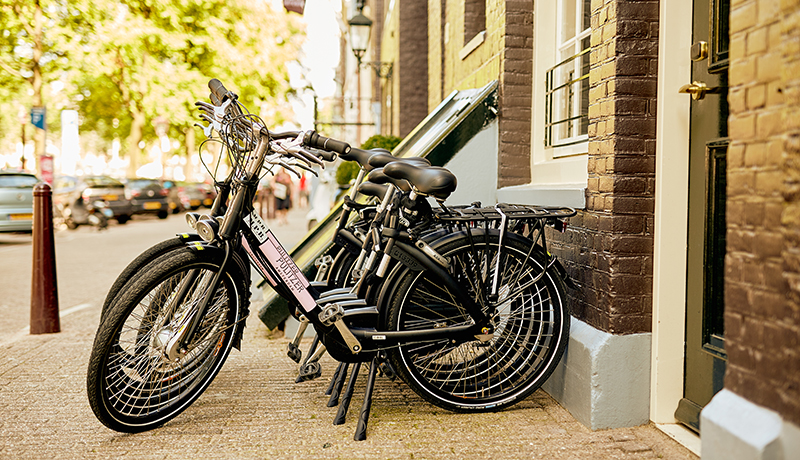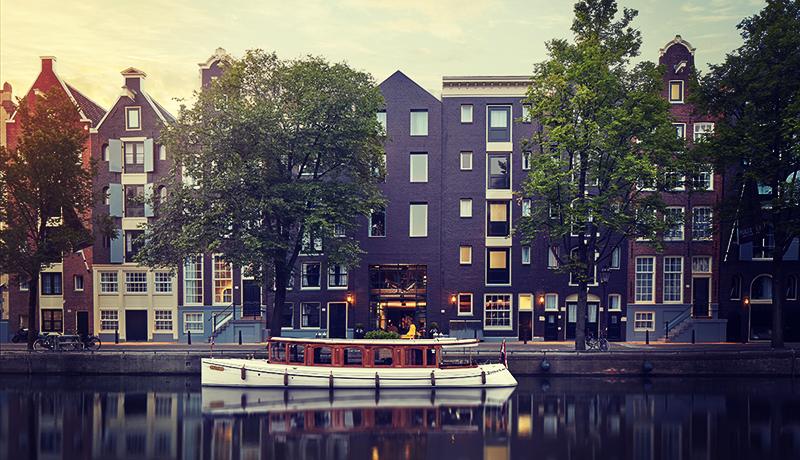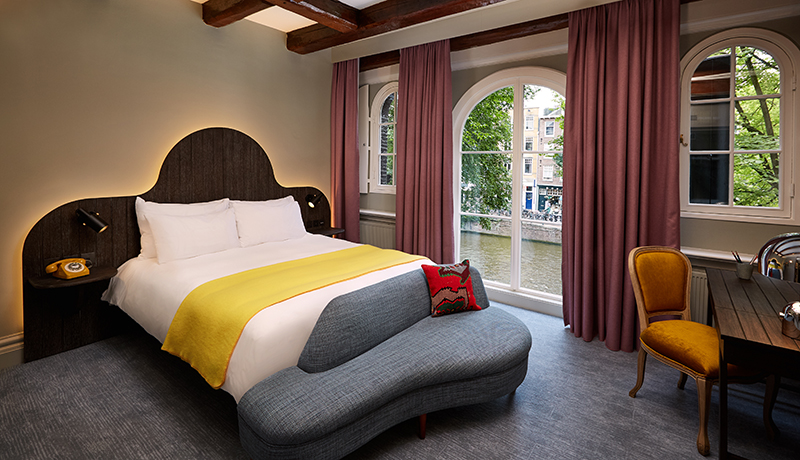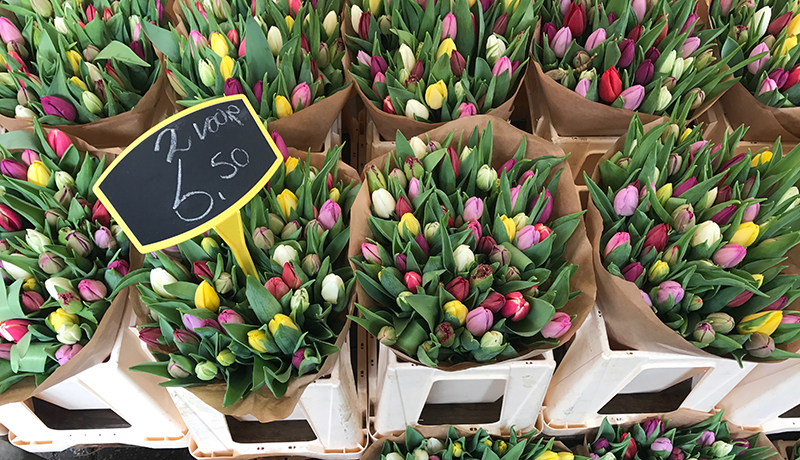

Charming Amsterdam, Photo Credit: Pulitzer Amsterdam
Amsterdam, with its tall gabled houses and winding canals, is a sight to behold any time of year. But once winter’s chill melts into budding spring, tulip season transforms the charming 17th-century port city into a veritable storybook setting.
From about mid-March through June, flower lovers flock to the capital of the Netherlands to experience the city in bloom before balmier summer weather kicks in. But with food, art and music events happening all throughout the year, there’s never a dull moment in the Venice of the North.
And now that Eurostar is launching direct high-speed train service to Amsterdam from London, joining other hot spots like Paris and Brussels, a weekend trip to Holland is more accessible than ever — and can be done without the hassle of air travel. All seats feature plenty of space, a generous luggage allowance (two suitcases plus hand luggage and no liquid restriction) plus food and drinks created by acclaimed chef Raymond Blanc in Business Premier.
With this two-day itinerary, the fun only continues once the train stops at the station.
Day One
Arriving at Amsterdam Centraal station is an eye-opening introduction to the city’s widespread cycling culture. Upon exiting the station, you will be greeted with racks upon racks of bikes. In fact, there are more bikes than people in the city, so it’s important to be aware of passing cyclists before stepping into one of the many wide bike lanes to cross the street.
If you’re up for the adventure, hopping on two wheels is a fantastic way to see the (entirely flat) city — and most hotels offer free rentals to guests.

Pulitzer Amsterdam’s King Canal Room, Photo Credit: Pulitzer Amsterdam
Canal-facing accommodations are the hot ticket in Amsterdam and there are some incredible options when it comes to hotels with a view. Still, none quite captures the essence of the city like Pulitzer Amsterdam. The hotel sits in the city’s historic center, along Prinsengracht (Prince’s Canal), within 25 restored 17th- and 18th-century houses once inhabited by trade merchants.
Originally opened by the grandson of Joseph Pulitzer, the iconic property was just recently reimagined by designer Jacu Strauss, who’s given it a charming, playful feel with bold pops of color, rich textures and unique pieces of art around every corner.
For an unforgettable stay, book one of the four exquisite Collectors Suites. The Music Collector’s Suite is adorned with antique instruments and stocked with vintage records and a record player cabinet, while the Art Collector’s Suite feels akin to a contemporary gallery.
Not only are bikes available for borrowing, but the hotel also owns a classic salon boat that can be reserved for private cruises. Canal tours are both a beautiful way to see the city and helpful in getting acquainted with its intricate canal network. Make it a floating picnic by boarding with Dutch beer and the region’s famed cheeses like Gouda, Geitenkaas or Maasdammer.

The Locals’ Preferred Mode of Transportation, Photo Credit: Pulitzer Amsterdam
Despite its peaceful ambience, the Pulitzer is situated conveniently close to many major tourist attractions. Just down the street, in fact, is the famed Anne Frank House, which is typically wrapped with a long line throughout the day. Avoid lengthy wait times by securing one of the limited advance tickets released online.
The gilded Royal Palace is also just a short stroll from the hotel, in Dam Square, and a guided tour will provide an intriguing overview of Amsterdam’s noble beginnings.
Afterward, unwind with a regal high tea experience at The Duchess, a newly opened restaurant in an old bank building now serving as one half of W Amsterdam.
Set aside time to explore the hip Negen Straatjes (“Nine Streets”), an area of the city known for its vintage shops (like the beloved Laura Dols) and boutiques from Dutch designers like Karl Lagerfeld and Scotch & Soda. The nine narrow streets are also peppered with plenty of places to stop for food and drink, from traditional Dutch cuisine at ’t Zwaantje to coffee and apple pie at Screaming Beans.
Be sure to save room (and book far in advance) for dinner at the noted Restaurant Vinkeles at The Dylan Amsterdam, where chef Dennis Kuipers’ contemporary Dutch cuisine is rooted in French technique and executed using ingredients that change with the seasons. Opt for a chef’s table experience to watch as your food is prepared before noshing on seven courses — with the restaurant’s own handcrafted knives, of course — that have been paired with wine.
The city center offers plenty of options for after-dinner drinks. Try local wine at Vyne along the Prinsengracht and sample your way through the exclusively Dutch beers being poured at Arendsnest.
Learn about genever (the juniper-based spirit that evolved into gin) and sample right from the barrels at De Drie Fleschjes and then discover how it’s used in well-crafted cocktails at Tales & Spirits. Ask about the off-menu drinks and you might just find yourself holding a parasol and sipping from a doll-sized bathtub.
Day Two
A trip to Amsterdam isn’t complete without trying pannekoek, Dutch pancakes that are larger and thinner than the American variety yet thicker than French crepes. The Pancake Bakery serves a wide range of savory and sweet options, plus poffertjes, small fluffy pancakes served with sugar, warm cherries, walnut ice cream or other toppings.
Keukenhof Gardens, the region’s most famous collection of bulb-sprung blooms, is in the town of Lisse, just a short bus ride from Amsterdam. But when on a short weekend trip, opt instead for a visit to Bloemenmarkt, the world’s only floating flower market. Located in the southern canal belt, it’s one of the most fragrant and colorful places in town — and open all seasons, too.
Food lovers will delight in the many open-air food markets also found around town, from Lindengracht Markt and Noordermarkt in Jordaan to Albert Cuyp Markt in De Pijp. Wander the rows of stalls selling fresh juice, flowers, baked goods and Dutch snacks, like still-warm stroopwaffels pressed together with sweet syrup, or broodje haring, cured herring served in a sandwich with pickles and onions.
Pay an afternoon visit to Foodhallen, Amsterdam’s first indoor food hall built in a renovated tram depot, to sample more local snacks like bitterballen (fried gravy) and kibbeling (fried cod served with lemon and aioli).

Flower Power, Photo Credit: Veronica Meewes
There are so many museums in Amsterdam, the best way to experience them all is with an I Amsterdam city card, available in activations ranging from 24 to 96 hours. In addition to the famed Van Gogh Museum, be sure to dedicate a good chunk of the day to viewing the art of both Dutch masters and contemporaries at the Rijksmuseum, which reopened in 2013 after closing for a massive 10-year renovation. Other highlights include the Foam photography museum and the Cobra Museum of Modern Art.
If the popular Heineken Experience is on your bucket list, be sure to factor in time for a bike ride or stroll through De Pijp, the neighborhood where the brewery resides.
The city’s Latin Quarter is filled with restaurants, cafés (like Coffee & Coconuts, which specializes in coconut-themed offerings) and shops (such as Hutspot, a concept department store housed in a former syrup factory).
Because Indonesia was a colony of the Netherlands for nearly 150 years, Indonesian culture has left its mark on Amsterdam in the form of food. Experience a rijsttafel (“rice table”), which arrives as a feast of 20 to 30 small dishes (in varying degrees of spiciness), accompanied by rice and sauces like sambal and peanut satay.
Bike through beautiful Vondelpark and end up at Blauw for a traditional spread, or opt for a more contemporary interpretation, like the creative Dutch-Indonesian cuisine at Max Restaurant.
Close out the night by hopping to one of Amsterdam’s several signature brown cafés, intimate pubs named from the dark wood paneling lining their walls. Café Pieper, established in 1665, is one of the city’s oldest bars and features a range of Dutch beers on tap, original stained glass, a terrace overlooking the canal and a layer of sawdust on the floor.
Nearby Café de Dokter, the tiniest bar in the city, has been owned by the same family since 1798. Tuck into a small table and marvel at the antique décor while sipping on the whiskey of the month or enjoying boozy boerenmeisjes (brandied apricots).
The Dutch have a feeling they call gezellig, which is comparable to the Danish notion of hygge (“a pleasant sense of warmth and coziness”). Visit one of these candlelit brown cafés and this sense of gezelligheid (coziness) will be so palpable you’ll likely have a hard time leaving.
